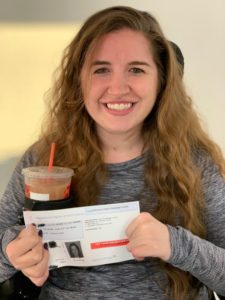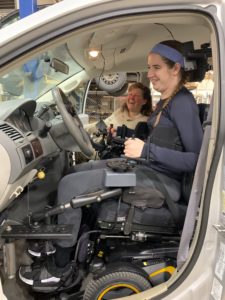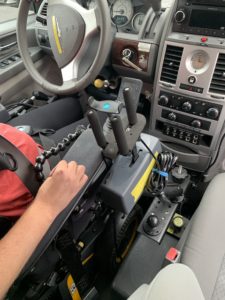
Back on Dec. 31, 2015, Denna Laing took the ice for the 2016 Outdoor Women’s Classic, the first outdoor professional women’s hockey game.
Denna, a two-time captain at Princeton, would be playing for the Boston Pride of the National Women’s Hockey League, facing off against Les Canadiennes de Montreal of the Canadian Women’s Hockey League.
It was a historic night for women’s hockey, and Denna was proud to be one of the pioneers.
Tragically, a night that was supposed to be one of euphoric satisfaction became life-changing in all the wrong ways. Denna crashed into the boards, and suffered a severe spinal cord injury. She was left with no feeling in her legs and limited movement of her arms.
Now, four years later, Denna has worked hard to gain strength in her upper body and core muscles, but the absence of feeling in her legs remains, as does limited movement in her arms to the point of having essentially no movement in her fingers.
And yet, on Tuesday, Feb, 4, Denna Laing earned her driver’s license.
Yes, her driver’s license.
“I was ecstatic, and really relieved,” Denna says. “There were a lot of bumps in the road during the process. It felt great to get the stamp of approval that I had been working so hard and long for.”
It was the culmination of a nine-month process.
“It starts off with an in-office evaluation with an occupational therapist who assesses your strength and your cognitive awareness of different driving rules of the road and things like that,” Denna says. “They measure and get everything set up from a medical standpoint to what they’re going to suggest for the driving instructor.
“Then you follow up that evaluation with another evaluation with the driving instructor. That’s an in-van evaluation where you go through the different technologies and see what’s really going to work for you and what’s not.”
Although a lot of technology now exists to address these needs, “adaptive drivers” can vary widely in their physical capabilities. Denna’s hard work to gain upper body and core strength helped considerably, but her limited range of mobility still eliminated some solutions. For example, some adaptive drivers can use a hand control, a little knob, right on the steering wheel. Denna’s range of motion, however, precluded the tall steering wheel.
After the multiple evaluations, however, Denna and her driving instructor finally arrived at a working solution customized to her needs.

“The setup is pretty cool actually,” Denna says. “They take the driver’s seat out completely so I can pull in my wheelchair right up into where the driver’s seat would be.
“I have a mini steering wheel that takes about five or six revolutions compared to the standard steering wheel. You can put that anywhere, so it really is accessible for a lot of people with a lot of different ranges of motion.
“I have that small wheel on the left side with my left hand. I don’t have any grip strength, so I hold onto it with something called a Tri-Pin. There’s a pin that goes in between my fingers, like if you’re making a fist, and then two pins that go on either side of your wrist.
“Then for the gas and the brake, I have that on my right side, and there’s also a Tri-Pin for that. You push it forward for gas, pull it back for brake.
“For secondary functions like the blinkers or changing the gears from drive to park, I do that all with a button that makes different tones. For example, if I hold down the button for two tones, that’s my right blinker. All of that is customizable.”
With a working solution determined, it was time to set up driving lessons. Few driving schools, however, can accommodate adaptive drivers. There’s the need for a trained instructor as well as a van for practice that can be interchangeably set up to meet each student’s specific needs.
In a frustrating irony, Denna found herself being driven almost an hour and a half from her house to get driving instruction. And then when that driving instructor was so heavily booked that few openings for lessons were available, Denna had to switch to another school and instructor, still an hour away.
The driver’s reeducation process, which typically follows years of grueling rehab, tests the patience of adaptive drivers. Denna relied on lessons learned in her years as an athlete.

“Mental toughness and the kind of patience you learn playing sports and playing hockey has definitely been integral to both my recovery process and the relearning-how-to-drive process,” Denna says. “It’s definitely not easy, and it’s definitely a long-game type of situation.
“As a hockey player and as an athlete, you’re always looking at those big-time, long-term goals. You just have to stay the course and put in the effort all season—or put in the effort for a couple of years—to try to reach those big endgame goals.”
That effort ultimately led to Denna earning her driver’s license, a wonderful, hard-earned milestone.
But it was accomplished in an interchangeable rental van like the ones the adaptive driving schools use. Denna won’t be able to put that license to work until she has her own customized van.
“When I do go through that process, everything will be set up perfectly for me,” Denna says. “But that’s a pretty lengthy process because everybody has a different setup, and it’s very, very expensive.”
When that happens, Denna doesn’t have a specific dream destination in mind. There’s no Super Bowl MVP-like trip to Disney World planned.
No, the dream is more basic.
“For me, it’s less about the destination and more about the opportunity to get where I want on my own time,” Denna says. “The freedom is the dream.”
Readers looking to help with that dream can donate at www.dennalaing.org.
The Denna Laing story doesn’t end here. This isn’t the finish line.
“I have some exciting things coming up, and I’m hoping for some really good results,” Denna says. “I can’t wait to share them with everyone.”
———–
Thanks to Cherie Hendrickson for her assistance.


